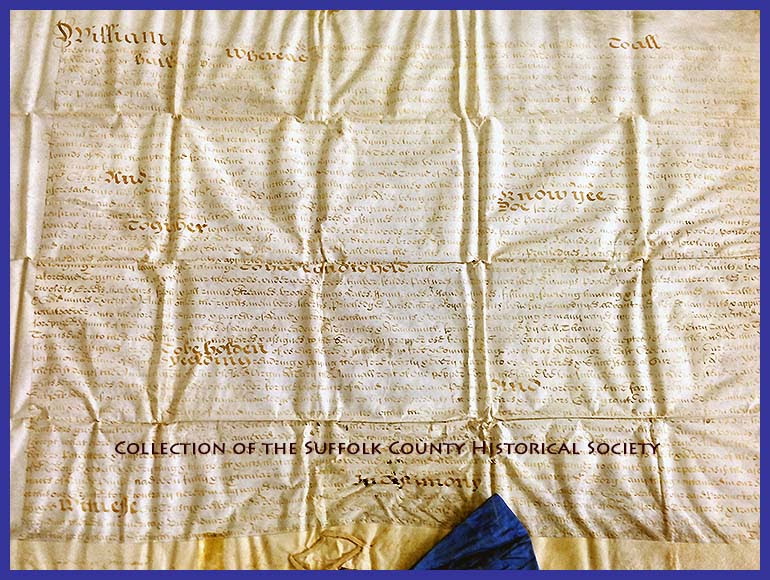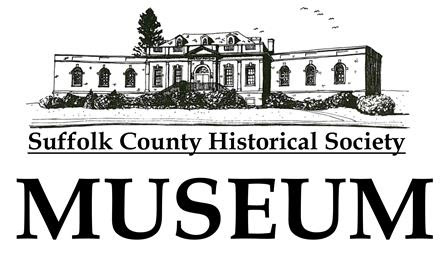
Photo of the Week
— May 24th —
FROM THE SCHS LIBRARY ARCHIVES
“How shall we know it is us without our past?”
– John Steinbeck
~~~~~~~~~~~~~~~~~~~
Land Grant for the Manor of St. George, 1697
by Wendy Polhemus-Annibell, Head Librarian
********

Land Grant for the Manor of St. George, Shirley, NY, 1697. Ink on vellum, 63 x 46 cm. (From the Collection of the Suffolk County Historical Society Library Archives. Copyright © Suffolk County Historical Society. All rights reserved.)
This patent for the Manor of St. George was granted by Governor Fletcher of New York to Colonel William “Tangier” Smith in 1697. It is one of the best-preserved seventeenth-century documents in our library archives.
The Manor of St. George is an important chapter in the history of Long Island, the United States, and the colonies that preceded them. Colonel William Smith had filed application with the governor, formally petitioning that his estate be erected into a manor to be known as the Manor of St. George. In those days in New York’s rural districts, many great manorial estates came into being. The proprietor was known as the Lord of the Manor and that title denoted an ownership of land invested with ancient and extensive priviliges.
For more than three centuries, the Manor of St. George was occupied by the Col. William Tangier Smith family. The Manor was also the scene of a famous revolutionary war battle: After the British captured Long Island in the War of 1776, the Manor of St. George became Fort St. George, a British-held bastion and supply base for land and sea forces, because of its proximity to the inlet that then existed in the barrier beach opposite Mastic, and because the British coveted the woods in its forests. Fort St. George was short-lived in British hands; in 1780, it was recaptured in a surprise 4 a.m. attack by American forces led by Col. Benjamin Tallmadge.
*****************

UPCOMING EXHIBIT: In our Staas Gallery beginning June 11, 2021. Before the 1800s, art was largely reserved for the wealthy, but with the invention of lithography in 1796 – and particularly color lithography in 1837 – printers were able to mass-produce beautiful color prints that were cheap enough for anyone to buy. Suddenly, art was available to all from such notable printers as Louis Prang, Napoleon Sarony, and Currier and Ives. Featuring themes of nineteenth-century life in landscapes, cityscapes, seascapes, Civil War battle scenes, and rare examples of “lithographic Long Island,” this exhibit captures the evolution of an American art form.

Our Weathervane Book Shop, located in our
new front lobby, offers a wide variety of
Long Island Local History books for purchase.
We’re the only bookshop in town!
NEWLY ADDED TITLES
HOT OFF THE PRESS – JUST PUBLISHED!
World War II, Long Island: The Homefront in Nassau and Suffolk, by Christopher Verga
George Washington’s Long Island Spy Ring: A History and Tour Guide, by Bill Bleyer
Long Island Migrant Labor Camps: Dust for Blood, by Mark Torres
Visit our website for our complete booklist.
Call Lee to place your book orders:
631-727-2881 x102
Orders may be picked up at the Weathervane Book Shop or may be shipped to you.
*****************

www.suffolkcountyhistoricalsociety.org
~~~~~~~~~~~~~~~~~~~
To View 2014 Photo of the Week pages click here.
To View 2015 Photo of the Week pages click here.
To View 2016 Photo of the Week pages click here.
To View 2017 Photo of the Week pages click here.
To View 2018 Photo of the Week pages click here.
To View 2019 Photo of the Week pages click here.
To View 2020 Photo of the Week pages click here.
To View 2021 Photo of the Week pages click here.
———————–

————————–
============================================


AAQ / Resource
Buzz Chew Chevrolet – Cadillac
_______________________________________________
